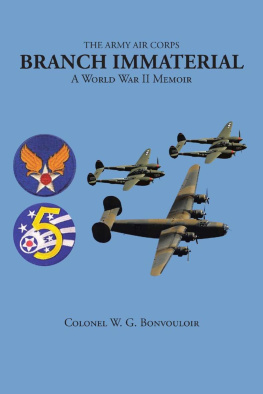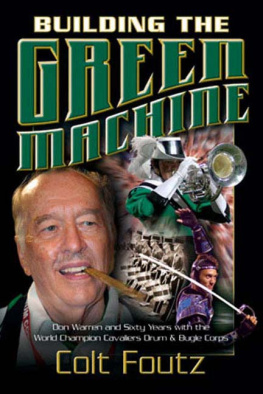The Army Air Corps: Branch Immaterial
A World War II Memoir
Colonel W. G. Bonvouloir
Copyright 2019 by Colonel W.G. Bonvouloir
All rights reserved. No part of this publication may be reproduced, distributed, or transmitted in any form or by any means, including photocopying, recording, or other electronic or mechanical methods without the prior written permission of the publisher. For permission requests, solicit the publisher via the address below.
Christian Faith Publishing, Inc.
832 Park Avenue
Meadville, PA 16335
www.christianfaithpublishing.com
Printed in the United States of America
Table of Contents
This is a personal memoir and any mistakes are lapses of memory of W. G. Bonvouloir.
No part of this book may be reproduced or utilized in any form or by any means, electronic, or mechanical, including photocopying, recording, or by any information storage and retrieval system without permission in writing.
Inquiries should be addressed to:
vbonvouloir@gmail.com
In tribute to our dad, W.G. Bonvouloir, and our mom, Nancy.
May they be smiling down on all their descendants.
In grateful appreciation for their love and guidance and love of country.
V-Mail Letters
V-MAIL letter in actual size
Below is an example of a V...MAIL letter from my Dad to Mom shortly after he arrived in Australia. The original letter was written on a prescribed form that measured 8 " x 11" . Instructions told you to write on the one side then fold on the lines indicated and then in half. On one side were instructions on the other side were places for the address, return address and six cents airmail postage. The service member did not have to attach postage. It was then reduced in size to 4 " x 5 3/8" and sent on photographic paper as the following letter.
This letter was sent at Christmas of 1944.
Foreword
Artillery? Armor? Infantry? Medical? Chemical? Ordnance? Transportation? If you are none of those, what are you?
Branch Immaterial
When your unit or branch of the Army is not designated Infantry, Artillery, Armor, Judge Advocate General, Chemical, Medical, et al., then you must be Branch Immaterial (BI).
This is my dads story of how at the beginning of the Second World War, men were pulled from all branches of the Army. They managed to create and man the Army Air Corps, which became the 2 nd Air Force and later morphed into the 5 th Air Force in the Pacific and 8 th Air Force in Europe.
This is a personal memoir. Names that mean a great deal to me and my sisters may not mean anything to you, but they are the men and women with whom our dad worked and served, and they too need to be remembered along with the greats who are mentioned often. This first chapter deals with the mission. Build an air force. The following chapters deal with how they did it. And it deals with his personal problems of wife and family. It is a picture of our dad, W.G. (Bon) Bonvouloir. We hope you enjoy the story and the incredible things they accomplished when the chips were down. What they did would be impossible today. There was a job to be done, and they did it. He always said, The difficult we do immediately, the impossible takes a little longer.
Our dad was an inveterate notetaker and journal keeper. He kept extensive records. There are file cabinets full of records, diaries, military orders, letters, and minutiae. This manuscript was found almost twenty years after his death. It is as accurate as he could make it.
Our story begins with The Ton and a Half Majors and then continues to his personal story and how he became involved in this great saga.
Chapter 1
The Ton and a Half Majors
General Olds looked around the table and made eye contact with the first one of the assembled officers and said, Major Hyatt, you are going to Pyote, Texas. It is a spot on the map about two hundred air miles east of El Paso and fifty miles west of Odessa.
You will build a ten-thousand-foot runway, install fuel storage with an aqua system, arrange with the railroad for necessary trackage, build shops, maintenance buildings, and housing for three thousand troops, and be prepared to start flying operations within the next sixty days.
He continued around the table until all had received their assignments.
There are no officers available for assignment. You will have to recruit and organize your own key personnel to start work. Cadres and replacement personnel for your air base units will be forthcoming.
To get you started, each of you will see Major Bonvouloir after this meeting and give him the names of five men above draft age you would like to have. Bon will make necessary arrangements.
Any questions? As he paused for a moment, the audience was too shell-shocked to react before he continued. Good luck, gentlemen, the meeting is adjourned.
How did you meet Carlton Ketchum? I have been often asked, followed by, What were the Ton and a Half Majors?
In early 1942, I was in charge of the Officers Section G-l (Assistant Chief of Staff Personnel) of the 2 nd Air Force at Fort George Wright, Washington. My commander was Colonel Pearne C. Wilders, INF GSC, who, like me, had been transferred to the Air Corps as BI (Branch Immaterial) to assume staff duties and release rated Air Corps officers for duty with tactical units.
By way of background, it must be remembered that the Air Corps of the United States Army prior to the start of World War II consisted of approximately 2,400 officers, 14,000 enlisted men, plus about 1,000 reserve officer pilots. As a branch of the Army, the Air Corps received logistical support and services, as did the other combat branches, from the Quartermaster, Signal Corps, Corps of Engineers, Medical Corps, Ordnance Department, Adjutant General, et al. In 1940, the Army began transferring regular and reserve officers of line branches: Infantry, Cavalry, Artillery, and Coast Artillery to the Air Corps to assume nonflying duties.
In May 1942, shortly after Major General Robert E. Olds had assumed command of the 2 nd Air Force, I was summoned to his office and ordered to proceed to Washington, DC. The general explained that I was to contact the newly created section of Appointment and Procurement (AP). This section had been organized for the purpose of recruiting qualified civilians above draft age for direct commission in the Air Corps.
My instructions were to review the records of individuals who had qualified as pilots in World War I and were thus entitled to wear the wings of a rated officer. I was to select thirty-two men so qualified with backgrounds of success in business and industry; men who, by experience and demonstrated performance, could with minimal training assume the responsibility of commanding an Air Corps installation. Under the law, only rated personnel, entitled to wear wings, were authorized to command Air Corps units.
As a backdrop for this mission, the first of many trips to Washington during the war years, it might be helpful to detail the status of the 2 nd Air Force prior to the arrival of General Robert Olds a few weeks before. At the time of Pearl Harbor, the 2 nd had seven bases: Geiger Field at Spokane, Washington; Pendleton Field, Pendleton, Oregon; Gowen Field, Boise, Idaho; Salt Lake City, Utah; Paine Field at Everett; McChord Field at Tacoma, in Washington; and another in Portland, Oregon.










